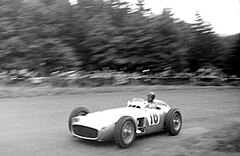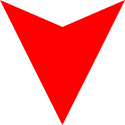Grand Prix Niemiec 1954
| ||||
| 38. Grand Prix Formuły 1 | ||||
 | ||||
| Data | 1 sierpnia 1954 | |||
| Trasa | ||||
| Liczba okrążeń | 22 | |||
| Długość okrążenia | 22,810 km | |||
| Dystans | 501,820 km | |||
| Uczestnicy | ||||
| Zgłoszenia | 23 kierowców | |||
| Zakwalifikowało się | 23 kierowców | |||
| Ukończyło wyścig | 10 kierowców | |||
| Wyniki | ||||
| Pole position | Juan Manuel Fangio (9:50,1, Mercedes) | |||
| Zwycięzca | Juan Manuel Fangio (3:45:45,8, Mercedes) | |||
| Najszybsze okrążenie | Karl Kling (9:55,1, Mercedes) | |||
| 6. Grand Prix w sezonie 1954 | ||||
| Poprzednie | Grand Prix Wielkiej Brytanii | |||
| Następne | Grand Prix Szwajcarii | |||
| Grand Prix Niemiec | ||||
| ||||

Grand Prix Niemiec 1954 (oryg. Großer Preis von Deutschland), Grand Prix Europy 1954[a] – 6. runda Mistrzostw Świata Formuły 1 w sezonie 1954, która odbyła się 1 sierpnia 1954 po raz 4. na torze Nürburgring.
14. Grand Prix Niemiec, 4. zaliczane do Mistrzostw Świata Formuły 1.
Onofre Marimón zginął podczas sesji treningowej. Dwaj kierowcy Maserati: Luigi Villoresi i Ken Wharton zrezygnowali ze startu na znak żałoby. Była to najdłużej trwająca Grand Prix w historii Formuły 1 (nie licząc Grand Prix na torze Indianapolis), która trwała 3 godziny 45 minuty 45,8 sekund.
Wyniki
Kwalifikacje
Źródło: statsf1.com[1]
| P | Nr | Kierowca | Konstruktor(-silnik) | Opony | Czas | Odstęp | Strata |
|---|---|---|---|---|---|---|---|
| 1 | 18 | Mercedes | C | 9:50,1 | - | - | |
| 2 | 3 | Ferrari | P | 9:53,3 | +3,2 | +3,2 | |
| 3 | 16 | Maserati | P | 10:00,7 | +7,4 | +10,6 | |
| 4 | 20 | Mercedes | C | 10:01,5 | +0,8 | +11,4 | |
| 5 | 1 | Ferrari | P | 10:01,8 | +0,3 | +11,7 | |
| 6 | 10 | Gordini | E | 10:05,9 | +4,1 | +15,8 | |
| 7 | 2 | Ferrari | P | 10:07,5 | +1,6 | +17,4 | |
| 8 | 6 | Maserati | P | 10:11,4 | +3,9 | +21,3 | |
| 9 | 9 | Gordini | E | 10:11,9 | +0,5 | +21,8 | |
| 10 | 5 | Maserati | P | brak danych | - | - | |
| 11 | 21 | Mercedes | C | 10:13,1 | +1,2 | +23,0 | |
| 12 | 24 | Ferrari | P | 10:16,1 | +3,0 | +26,0 | |
| 13 | 4 | Ferrari | P | 10:23,0 | +6,9 | +32,9 | |
| 14 | 15 | Maserati | P | 10:28,7 | +5,7 | +38,6 | |
| 15 | 7 | Maserati | P | 10:39,1 | +10,4 | +49,0 | |
| 16 | 11 | Gordini | E | 10:43,7 | +4,6 | +53,6 | |
| 17 | 8 | Maserati | P | 10:47,0 | +3,3 | +56,9 | |
| 18 | 25 | Ferrari | D | 11:04,3 | +17,3 | +1:14,2 | |
| 19 | 14 | Maserati | P | 11:10,3 | +6,0 | +1:20,2 | |
| 20 | 12 | Gordini | E | 11:13,4 | +3,1 | +1:23,3 | |
| 21 | 22 | Klenk-BMW | P | 11:18,3 | +4,9 | +1:28,2 | |
| 22 | 17 | Maserati | D | brak czasu | - | - | |
| 23 | 19 | Mercedes | C | brak czasu | - | - | |
| P | Nr | Kierowca | Konstruktor(-silnik) | Opony | Czas | Odstęp | Strata |
Wyścig
Źródła: statsf1.com[2]
| P | + / – | Nr | Kierowca | Konstruktor | Opony | Okr. | Czas / Strata | Komentarz |
|---|---|---|---|---|---|---|---|---|
| 1 | | 18 | Mercedes | C | 22 | 3:45:45,8 | ||
| 2 | 1 | Ferrari | P | 16 6 | +1:36,5 | |||
| 3 | 2 | Ferrari | P | 22 | +5:08,6 | |||
| 4 | 19 | Mercedes | C | 22 | +6:06,5 | |||
| 5 | 7 | Maserati | P | 22 | +8:50,5 | |||
| 6 | 4 | Ferrari | P | 21 | +1 okr. | |||
| 7 | 15 | Maserati | P | 21 | +1 okr. | |||
| 8 | 25 | Ferrari | D | 21 | +1 okr. | |||
| 9 | 24 | Ferrari | P | 20 | +2 okr. | |||
| 10 | 9 | Gordini | E | 20 | +2 okr. | |||
| Niesklasyfikowani | ||||||||
| 14 | Maserati | P | 18 | +4 okr. | układ sterowniczy | |||
| 21 | Mercedes | C | 10 | +12 okr. | poślizg | |||
| 11 | Gordini | E | 8 | +14 okr. | koło | |||
| 22 | Klenk-BMW | P | 8 | +14 okr. | silnik | |||
| 20 | Mercedes | C | 7 | +15 okr. | wyciek paliwa | |||
| 10 | Gordini | E | 4 | +18 okr. | koło | |||
| 3 | Ferrari | P | 3 | +19 okr. | przekładnia | |||
| 8 | Maserati | P | 2 | +20 okr. | wyciek paliwa | |||
| 16 | Maserati | P | 1 | +21 okr. | łożysko koła | |||
| 12 | Gordini | E | 0 | +22 okr. | zawieszenie | |||
| Nie wystartowali / niedopuszczeni do ponownego startu | ||||||||
| 6 | Maserati | P | 0 | śmiertelny wypadek podczas treningu | ||||
| 5 | Maserati | P | 0 | wycofał się | ||||
| 17 | Maserati | D | 0 | wycofał się | ||||
| P | + / – | Nr | Kierowca | Konstruktor | Opony | Okr. | Czas / Strata | Komentarz |
Najszybsze okrążenie
Źródło: statsf1.com[3]
| Nr | Kierowca | Konstruktor | Czas | Okr. |
|---|---|---|---|---|
| 19 | Mercedes | 9:55,1 | 16 |
Prowadzenie w wyścigu
Źródło: statsf1.com[4]
| Nr | Kierowca | Konstruktor | Okrążenia | Suma | ||
|---|---|---|---|---|---|---|
| 18 | Mercedes | 1-14, 17-22 | 20 | |||
| 19 | Mercedes | 15-16 | 2 | |||
Klasyfikacja po wyścigu
Pierwsza piątka otrzymywała punkty według klucza 8-6-4-3-2, 1 punkt przyznawany był dla kierowcy, który wykonał najszybsze okrążenie w wyścigu[5]. Klasyfikacja konstruktorów została wprowadzona w 1958 roku. Liczone było tylko 5 najlepszych wyścigów danego kierowcy.
Uwzględniono tylko kierowców, którzy zdobyli jakiekolwiek punkty
| P | +/- | Kierowca | Starty | Punkty | P1 | P2 | P3 | PP | NO | NS |
|---|---|---|---|---|---|---|---|---|---|---|
| 1 | 0 | 5 | 36,14 | 4 | - | - | 4 | 2 | - | |
| 2 | 0 | 5 | 17,64 | 1 | 1 | 1 | - | 2 | 1 | |
| 3 | 0 | 5 | 15 | - | 1 | 1 | - | - | 1 | |
| 4 | +1 | 5 | 10,64 | - | 2 | - | - | 1 | 2 | |
| 5 | +1 | 3 | 10 | - | 1 | - | - | 1 | - | |
| 6 | -2 | 1 | 8 | 1 | - | - | - | - | - | |
| 7 | 0 | 2 | 6 | - | 1 | - | 1 | - | 1 | |
| 8 | 0 | 1 | 6 | - | 1 | - | - | - | - | |
| 9 | 0 | 1 | 5 | - | - | 1 | 1 | 1 | - | |
| 10 | 0 | 4 | 4,14 | - | - | 1 | - | 1 | 3 | |
| 11 | 0 | 3 | 4,14 | - | - | 1 | - | 1 | 2 | |
| 12 | 0 | 3 | 4 | - | - | 1 | - | - | 1 | |
| 13 | 0 | 5 | 3 | - | - | - | - | - | 2 | |
| 14 | N | 2 | 2 | - | - | - | - | - | - | |
| 15 | -1 | 3 | 2 | - | - | - | - | - | 1 | |
| 16 | -1 | 2 | 2 | - | - | - | - | - | 1 | |
| 17 | -1 | 1 | 2 | - | - | - | - | - | - | |
| 17 | -1 | 1 | 2 | - | - | - | - | - | - | |
| 19 | -1 | 1 | 1,5 | - | - | - | - | - | - | |
| 19 | -1 | 1 | 1,5 | - | - | - | - | - | - | |
| 21 | -1 | 2 | 1 | - | - | - | - | 1 | 2 | |
| 22 | -1 | 5 | 0,14 | - | - | - | - | 1 | 3 | |
| 23 | -1 | 2 | 0,14 | - | - | - | - | 1 | 2 | |
| P | +/- | Kierowca | Starty | Punkty | P1 | P2 | P3 | PP | NO | NS |
Przypisy
- ↑ GERMANY 1954 Qualifications (ang.). statsf1.com. [dostęp 2021-03-01].
- ↑ GERMANY 1954 Result (ang.). statsf1.com. [dostęp 2021-03-01].
- ↑ GERMANY 1954 Best Laps (ang.). statsf1.com. [dostęp 2021-03-01].
- ↑ GERMANY 1954 Laps led (ang.). statsf1.com. [dostęp 2021-03-01].
- ↑ 1954 - STATS F1 (ang.). statsf1.com. [dostęp 2021-02-24].
Uwagi
- ↑ Do roku 1977 Grand Prix Europy było honorowym tytułem przyznawanym eliminacjom rozgrywanym w Europie.
Media użyte na tej stronie
The flag of Navassa Island is simply the United States flag. It does not have a "local" flag or "unofficial" flag; it is an uninhabited island. The version with a profile view was based on Flags of the World and as a fictional design has no status warranting a place on any Wiki. It was made up by a random person with no connection to the island, it has never flown on the island, and it has never received any sort of recognition or validation by any authority. The person quoted on that page has no authority to bestow a flag, "unofficial" or otherwise, on the island.
The national flag of Kingdom of Thailand since September 2017; there are total of 3 colours:
- Red represents the blood spilt to protect Thailand’s independence and often more simply described as representing the nation.
- White represents the religion of Buddhism, the predominant religion of the nation
- Blue represents the monarchy of the nation, which is recognised as the centre of Thai hearts.
Straight Line Steady, intended for use in Template:Infobox Company. Use {{steady}} in wikipedia to make small line for steady profit. Self-made.
Green arrow icon pointing up
Autor: Pitlane02, Licencja: CC BY-SA 3.0
Nürburgring, layout 1927–1966, the Nordschleife
Autor: Agridecumantes, Licencja: CC BY-SA 3.0
Juan Manuel Fangio w samochodzie Mercedes Benz W196 Monoposto, Grand Prix Europy Formuły 1, Nürburgring, 1 sierpnia 1954












